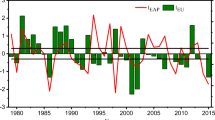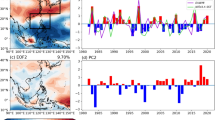Abstract
The anomalous characteristics of summer precipitation and atmospheric circulation in the East Asia–West Pacific Region (EA–WP) associated with the co-action of East Asia/Pacific teleconnection–Silk Road teleconnection (EAP–SR) are investigated in this study. The compositions of EAP–SR phase anomalies can be expressed as pattern I (+ +), pattern II (+ −), pattern III (− −), and pattern IV (− +) using EAP and SR indices. It is found that the spatial distribution of summer precipitation anomalies in EA–WP corresponding to pattern I (III) shows a tripole structure in the meridional direction and a zonal dipole structure in the subtropical region, while pattern II (IV) presents a tripole pattern in meridional direction with compressed and continuous anomalies in the zonal direction over the subtropical region. The similar meridional and zonal structures are also found in the geopotential height anomalies at 500-hPa, as well as wind anomalies and moisture convergence at 850-hPa. Finally, a schematic mechanism for the EAP–SR co-action upon the summer precipitation in EA–WP is built: (1) Pattern I (III) exhibits that the negative (positive) sea surface temperature (SST) anomalies over tropical East Pacific may cause the enhanced (weakened) convective activity dominating the West Pacific, trigger the positive (negative) EAP teleconnection and produce more (less) precipitation. Besides, the negative (positive) SST anomalies over the Indonesia Maritime Continent (IMC) may further weaken (strengthen) anomalous downward (upward) motion over the South China Sea (SCS), cause negative (positive) geopotential height anomalies at the middle troposphere and surrounding regions through the function of the tropical Hadley circulation. Then the negative (positive) geopotential height anomalies could motivate the positive (negative) EAP teleconnection through the northward propagation of wave-activity perturbation. Meanwhile, a positive (negative) geopotential height anomalous pattern over Eastern Europe motivates a Rossby wave train propagation from Western Europe to west-central Asia. This circumstance can cause suppressed (enhanced) convection and less (more) precipitation over northwestern India and Pakistan, which could strengthen the negative (positive) geopotential height and positive (negative) vorticity anomalies over central East Asia, resulting in a negative (positive) SR teleconnection along the Asian jet stream. A positive (negative) lobe over the Korean Peninsula and Japan corresponding to SR overlaps with a positive (negative) lobe of EAP, which strengthens the anomalous phase contrast on both sides of 120°E. Accordingly, summer precipitation anomalies in EA–WP exhibit the meridional tripole pattern and the zonal dipole pattern. (2) Pattern II (IV) indicates that the normal SST anomalies over the tropical East Pacific cause the weak tele-impact on the tropical West Pacific, while the positive (negative) SST anomalies over the IMC will lead to a negative (positive) lobe of EAP over the subtropical region. This circumstance can weaken the positive (negative) lobe of SR over subtropical region, causing compressed and continuous negative (positive) anomalies of 500-hPa geopotential height and positive (negative) surface precipitation anomalies from central East China to Japan.


















Similar content being viewed by others
References
Chen G, Huang R, Zhou L (2013) Baroclinic instability of the silk road pattern induced by thermal damping. J Atmos Sci 70:2875–2893
Cornejo-Garrido AG, Stone PH (1977) On the heat balance of the Walker circulation. J Atmos Sci 34:1155–1162
Ding Y (2007) The variability of the Asian summer monsoon. J Meteorol Soc Jpn 85:21–54
Ding Y, Chan J (2005) The East Asian summer monsoon: an overview. Meteorol Atmos Phys 89:117–142
Ding Q, Wang B (2005) Circumglobal teleconnection in the Northern Hemisphere summer. J Clim 18:3483–3505
Ding Q, Wang B, Wallace JM, Branstator G (2011) Tropical–extratropical teleconnections in boreal summer: observed interannual variability. J Clim 24:1878–1896
Dogar MM, Kucharski F, Azharuddin S (2017) Study of the global and regional climatic impacts of ENSO magnitude using SPEEDY AGCM. J Earth Syst Sci 126:30
Enomoto T, Hoskins BJ, Matsuda Y (2003) The formation mechanism of the Bonin high in August. Q J R Meteorol Soc 129:157–178
Feng G, Zhao J, Zhi R, Gong Z (2013) Recent progress on the objective and quantifiable forecast of summer precipitation based on dynamical statistical method. J Appl Meteorol Sci 24:656–665
Gong Z, Feng G, Ren F, Li J (2013) A regional extreme low-temperature event and its main atmospheric contributing factors. Theor Appl Climatol 117:195–206
Gong Z, Feng T, Fang Y (2015a) Objective identification research on cold vortex and mid-summer rainy periods in Northeast China. Chin Phys B 24:049204
Gong Z, Zhao J, Feng G, Chou J (2015b) Dynamic-statistics combined forecast scheme based on the abrupt decadal change component of summer precipitation in East Asia. Sci China Earth Sci 58:404–419
Gong Z, Hutin C, Feng G (2016) Methods for improving the prediction skill of summer precipitation over East Asia–West Pacific. Weather Forecast 31:1381–1392
Hoskins BJ, Karoly DJ (1981) The steady linear response of a spherical atmosphere to thermal and orographic forcing. J Atmos Sci 38:1179–1196
Hsu H, Lin S (2007) Asymmetry of the tripole rainfall pattern during the East Asian Summer. J Climate 20:4443–4458
Huang R (1987) Influence of the heat source anomaly over the tropical western Pacific on the subtropical high over East Asia. In: Proceedings of international conference on the general circulation of East Asia, April, pp 40–51
Huang G (2004) An index measuring the interannual variation of the East Asian Summer Monsoon—the EAP index. Adv Atmos Sci 21:41–52
Huang J, Yi Y, Wang S, Chou J (1993) An analogue-dynamical long-range numerical weather prediction system incorporating historical evolution. Q J R Meteorol Soc 119:547–565
Huang R, Zhang Z, Huang G, Ren B (1998) Characteristics of the water vapor transport in East Asian monsoon region and its difference from that in South Asian monsoon region in summer. Chin J Atmos Sci 22:469–479
Huang R, Chen J, Huang G, Zhang Q (2006) The quasi-biennial oscillation of summer monsoon rainfall in China and its cause. Chin J Atmos Sci 30:545–556
Huang R, Chen J, Huang G (2007) Characteristics and variations of the East Asian monsoon system and its impacts on climate disasters in China. Adv Atmos Sci 24:993–1023
Huang R, Chen J, Wang L, Lin Z (2012a) Characteristics, processes, and causes of the spatio-temporal variabilities of the East Asian monsoon system. Adv Atmos Sci 29:910–942
Huang R, Liu Y, Feng T (2012b) Interdecadal change of summer precipitation over Eastern China around the late-1990s and associated circulation anomalies, internal dynamical causes. Chin Sci Bull 58:1339–1349
Ishii M, Shouji A, Sugimoto S, Matsumoto T (2005) Objective analyses of sea-surface temperature and marine meteorological variables for the 20th century using ICOADS and the Kobe collection. Int J Climatol 25:865–879
Kosaka Y, Nakamura H (2006) Structure and dynamics of the summertime Pacific–Japan teleconnection pattern. Q J R Meteorol Soc 132:2009–2030
Kosaka Y, Nakamura H, Watanabe M, Kimoto M (2009) Analysis on the dynamics of a wave-like teleconnection pattern along the summertime Asian jet based on a reanalysis dataset and climate model simulations. J Meteorol Soc Jpn 87:561–580
Kosaka Y, Chowdary JS, Xie S, Min Y, Lee J (2012) Limitations of seasonal predictability for summer climate over East Asia and the Northwestern Pacific. J Clim 25:7574–7589
Kosaka Y, Xie SP, Lau NC, Vecchi GA (2013) Origin of seasonal predictability for summer climate over the Northwestern Pacific. Proc Natl Acad Sci USA 110:7574
Lau WKM, Kim K-M (2012) The 2010 Pakistan Flood and Russian Heat wave: teleconnection of hydrometeorological extremes. J Hydrometeorol 13:392–403
Li H, Dai A, Zhou T, Lu J (2008) Responses of East Asian summer monsoon to historical SST and atmospheric forcing during 1950–2000. Clim Dyn 34:501–514
Li X, Wen Z, Zhou W, Wang D (2012) Atmospheric water vapor transport associated with two decadal rainfall shifts over East China. J Meteorol Soc Jpn Ser II 90:587–602
Lu R (2004) Associations among the components of the East Asian summer monsoon system in the meridional direction. J Meteorol Soc Jpn 82:155–165
Lu R, Lin Z (2009) Role of subtropical precipitation anomalies in maintaining the summertime meridional teleconnection over the western North Pacific and East Asia. J Clim 22:2058–2072
Lu R, Li Y, Dong B (2006) External and internal summer atmospheric variability in the western North Pacific and East Asia. J Meteorol Soc Jpn 84:447–462
Masao K, Wesley E, Jack W, Shi-Keng Y, J. HJ MF, L. PG (2002) Ncep-doe amip-ii reanalysis (r-2). Bull Am Meteorol Soc 83:1631–1643
Nitta T (1987) Convective activities in the tropical western Pacific and their impact on the Northern Hemisphere summer circulation. J Meteorol Soc Jpn 65:373–390
Nitta T, Hu Z (1996) Summer climate variability in China and its association with. J Meteorol Soc Jpn 74:425–445
Qiao S, Gong Z, Feng G, Qian Z (2015) Relationship between cold winters over Northern Asia and the subsequent hot summers over mid-lower reaches of the Yangtze River valley under global warming. Atmos Sci Lett 16:479–484
Sato N, Takahashi M (2006) Dynamical processes related to the appearance of quasi-stationary waves on the subtropical jet in the midsummer Northern Hemisphere. J Clim 19:1531–1544
Stuecker MF, Jin FF, Timmermann A, McGregor S (2015) Combination mode dynamics of the anomalous Northwest Pacific Anticyclone. J Clim 28:1093–1111
Takaya K, Nakamura H (2001) A Formulation of a phase-independent wave-activity flux for stationary and migratory quasigeostrophic eddies on a zonally varying basic flow. J Atmos Sci 58:608–827
Wang B, Fan Z (1994) Choice of South Asian Summer Monsoon Indices. Bull Am Meteorol Soc 80:629–638
Wang B, Wu R, Lau KM (2001) Interannual variability of the Asian summer monsoon: contrasts between the Indian and the Western North Pacific-East Asian Monsoons. J Clim 14:4073–4090
Wang B, Jian L, Jing Y, Zhou TJ, Wu ZW (2009) Distinct principal modes of early and late summer rainfall anomalies in East Asia. J Clim 22:3864–3875
Wang B, Xiang B, Lee JY (2013) Subtropical high predictability establishes a promising way for monsoon and tropical storm predictions. Proc Natl Acad Sci 110:2718–2722
Webster PJ, Yang S (1992) Monsoon and ENSO: selectively interactive systems. Q J R Meteorolog Soc 118:877–926
Xu Z, Fan K, Wang H (2015) Decadal variation of summer precipitation over China and associated atmospheric circulation after the Late 1990s. J Clim 28:4086–4106
Yang F, Lau KM (2004) Trend and variability of China precipitation in spring and summer: linkage to sea-surface temperatures. Int J Climatol 24:1625–1644
Zhou T, Wu B, Wang B (2009) how well do atmospheric general circulation models capture the leading modes of the interannual variability of the Asian–Australian monsoon? J Clim 22:1159–1173
Acknowledgements
The authors wish to thank anonymous reviewers’ meaningful comments that led to a much-improved manuscript. Thanks also are extended to Dr. Pete Saunders for his great help in improving the writing of this manuscript. This work is supported by the National Natural Science Foundation of China (Grant Nos. 41575082, 41530531, and 41475064), the Special Scientific Research Project for Public Interest (Grant No. GYHY201306021).
Author information
Authors and Affiliations
Corresponding author
Rights and permissions
About this article
Cite this article
Gong, Z., Feng, G., Dogar, M.M. et al. The possible physical mechanism for the EAP–SR co-action. Clim Dyn 51, 1499–1516 (2018). https://doi.org/10.1007/s00382-017-3967-4
Received:
Accepted:
Published:
Issue Date:
DOI: https://doi.org/10.1007/s00382-017-3967-4




